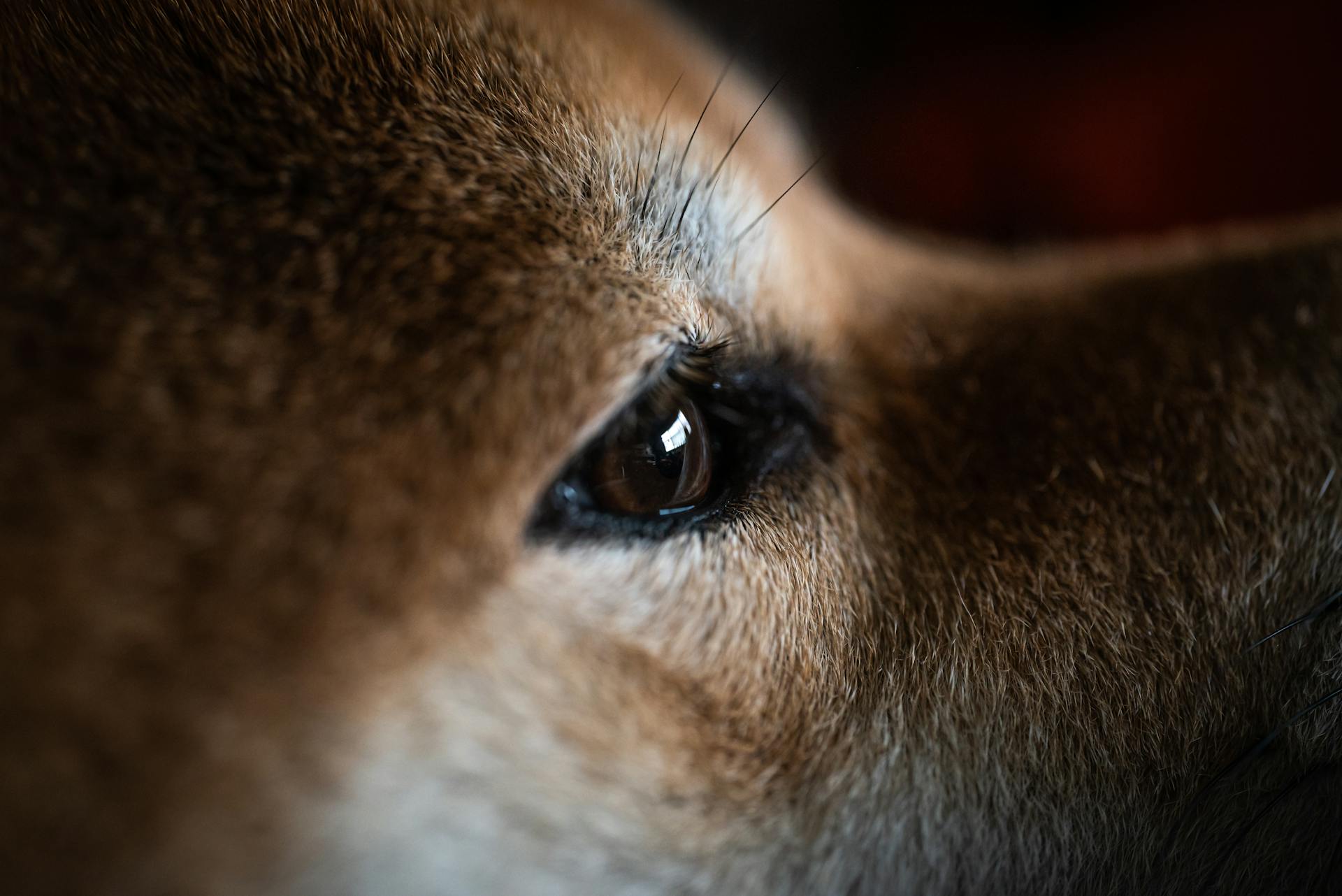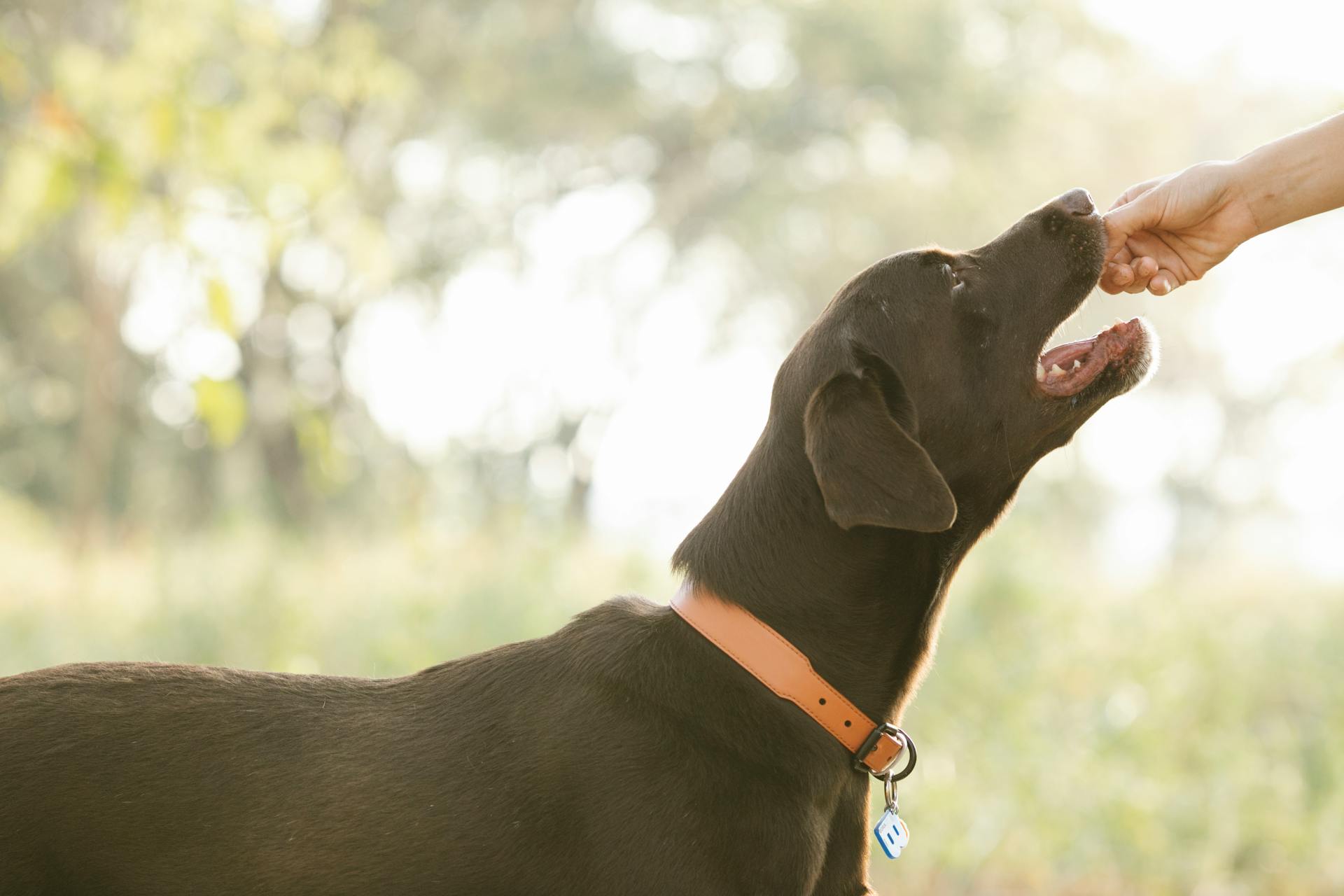
Labradors are prone to a genetic disorder called progressive retinal atrophy, which affects the retina and leads to blindness.
Progressive retinal atrophy is a degenerative eye disorder that causes the retina to deteriorate over time.
The condition is often inherited from a dog's parents, with certain breeds like Labradors being more susceptible due to their genetic makeup.
Labradors typically begin showing symptoms of progressive retinal atrophy between 5-10 years of age, although some may exhibit signs earlier.
As the disease progresses, affected dogs may experience night blindness, difficulty seeing in low light, and eventually complete blindness.
You might like: Service Dogs for Bipolar Disorder
Breed Predisposition
Labradors are a breed known to have a genetic predisposition to progressive retinal atrophy. This is due to a higher risk of genetic variants that can lead to the condition.
Some breeds have a higher frequency of genetic variants that can cause PRA. For example, the Briard has an especially high frequency of this genetic variant.
Labradors, Golden Retrievers, and Shetland Sheepdogs are among the breeds that have a higher risk of PRA due to genetic predisposition.
Here's a list of breeds known to have a higher risk of PRA due to genetic predisposition:
- Poodles
- Labrador Retrievers
- Golden Retrievers
- English and American Cocker Spaniels
- Australian Cattle Dogs
- Tibetan Terriers and Spaniels
- Basenjis
- Cardigan Welsh Corgis
- Papillons
- Irish Setters
- Shetland Sheepdogs
Poodles, in particular, are also known to be at a higher risk of PRA due to genetic predisposition.
Clinical Signs and Symptoms
Labradors can be prone to progressive retinal atrophy, a condition that affects their vision. It's essential to recognize the clinical signs and symptoms to address the issue early on.
Dilated pupils can be a sign of PRA, especially if they slowly constrict in response to light. This is a common trait in dogs with the condition.
Abnormally reflective eyes, especially in low light, are another indicator of PRA. The eyes may glow more than usual when a picture is taken with flash.
Reluctance to enter a dark room or go outside at night is a significant symptom of PRA. Dogs may initially be hesitant to venture out, but as the disease progresses, they may become more confident.
A different take: Pug Dog Eyes Pop Out
Bumping into door frames or being clumsy in new surroundings can be a sign of PRA. This is often more noticeable in low light or when the dog is in a new environment.
Here are some common symptoms of PRA in Labradors:
- Reluctance to go outside at night or enter a dark room
- Clumsiness and bumping into things
- Dilated pupils that slowly constrict in response to light
- Eyes that are more reflective in the dark
- Cataracts, which may be the first sign pet parents notice
Keep in mind that some dogs may adapt well to their vision loss and only be noticed when the environment changes. Regular eye testing can help detect PRA early on.
Diagnosis and Genetics
Diagnosis of Progressive Retinal Atrophy in Labradors typically starts with a veterinarian referring you to a veterinary eye specialist. A thorough eye exam focusing on the retina is essential to diagnose PRA.
Both eyes are equally affected by PRA, and dogs may also develop cataracts in the late stages of the disease. Your veterinarian may refer you to a veterinary eye specialist to confirm a diagnosis with additional testing, such as electroretinography (ERG).
Electroretinography (ERG) is a test that measures the response of the retina to light, which can be used to diagnose PRA, especially if cataracts block the retinas from view. This test can prove conclusively that your dog has PRA.
Suggestion: Canine Brucellosis Test
Genetic testing is available for all known variants of PRA, but researchers have not yet discovered all the variants that cause the disease. The existing tests can detect if a dog is at risk of developing PRA, or if they are merely a carrier of a variant but not at risk of developing the disease.
Progressive rod-cone degeneration (PRCD) is one of the most common forms of inherited PRA, and it's recessive, meaning two copies of the variant must be present to consider a dog at-risk. Dogs with two copies of the PRCD variant will almost always develop vision loss as an adult.
Some breeds are more susceptible to PRA, and in these breeds, specific genetic tests can be used to diagnose the disease. Absent a genetic test, animals of breeds susceptible to PRA can be cleared of the disease only by the passage of time—that is, by living past the age at which PRA symptoms are typically apparent in their breed.
Treatment and Management
Progressive retinal atrophy in Labradors is a degenerative eye disorder that affects a dog's ability to see. Management is key to helping your dog adjust to their condition.
To start, it's essential to keep your dog's environment constant, with furniture and objects in the same place, as this can help them adjust amazingly well to their condition. This means avoiding rearranging the furniture or moving objects around the house.
Supplemental lighting can be added inside and outside the house to help dogs with PRA, especially in the early stages when only night vision is affected. This can make a big difference in their ability to navigate their surroundings.
Gene therapy is a prospective treatment for some specific types of canine PRA, but it's not widely available and has only been used in research settings. Antioxidant supplements may also be recommended to improve retinal function and delay the formation of cataracts.
Take a look at this: Lab Dog House
However, it's essential to note that PRA cannot be treated, and dogs with this condition will eventually lose their sight. This means that dogs with PRA should not be bred.
To help your dog feel safe and secure, consider sticking to a routine and providing a familiar area where furniture and objects are seldom moved. You can also use verbal cues or gentle touches to help them navigate their environment.
Some other practical tips include using safety gates to block access to stairs, guiding them with a leash when in unknown areas, and training with verbal commands prior to vision loss. You can also use a leash and harness to help them navigate the house, yard, and new or unfamiliar areas.
Here are some specific tips for managing PRA in Labradors:
- Provide a safe, familiar area where furniture and objects are seldom moved.
- Use safety gates to block access to stairs.
- Train with verbal commands prior to vision loss.
- Use a leash and harness to help them navigate the house, yard, and new or unfamiliar areas.
- Stick to a routine and provide background noise, such as the TV or radio, to help them feel more secure.
Outcome and Sequelae
Unfortunately, nearly all dogs with PRA will eventually go completely blind. Dogs tend to acclimate well to vision loss, since most cases of PRA progress slowly, and affected dogs can go on to live otherwise healthy lives.
Explore further: Heat Cycle in Labrador Retrievers
Dogs with PRA will nearly always develop cataracts. This is a common sequela of the condition.
It's essential to closely monitor the eyes of dogs with PRA for signs of redness on the top of the eyeball. This could indicate a reaction to the cataract, which needs to be treated promptly to prevent severe pain.
In cases where cataracts develop, removing them may not provide lasting benefits to vision. However, veterinary advice should still be sought if redness or other issues arise.
Causes and Forms
Progressive retinal atrophy in Labradors is a complex condition with several forms and causes.
Labradors can be affected by two forms of PRA: early-onset and late-onset. Early-onset PRA occurs in puppies around 8-12 weeks of age and is often referred to as retinal dysplasia.
Late-onset PRA occurs in adult Labradors between 3-9 years old and is a true atrophy, where the rods and cones lose their ability to function.
PRA is an inherited disorder in dogs, and most Labradors are affected by an autosomal recessive trait, meaning they must inherit a defective copy of the gene from both parents.
In some breeds, including Labradors, PRA can be caused by a dominant gene, where a single defective copy of the gene is enough to cause the condition.
Labradors are at higher risk for late-onset PRA, which typically affects their vision around the 6 to 8 year mark.
Here are some breeds at higher risk for late-onset PRA, including Labradors: American Cocker SpanielAustralian Cattle DogAustralian ShepherdLabrador RetrieverGolden RetrieverChesapeake Bay RetrieverFrench BulldogItalian GreyhoundMastiffMiniature PoodleSamoyedSiberian HuskyShetland SheepdogTibetan TerrierToy Poodle
Take a look at this: English Cream Golden Retriever Lifespan
Rod-Cone Degeneration and Common Breeds
Labrador Retrievers are at high risk for rod-cone degeneration, a disease that can lead to blindness. This breed is often affected by the condition, with night blindness occurring between four to six years old and complete blindness at six to eight years old.
Some other breeds that are commonly affected by rod-cone degeneration include Golden Retrievers, Border Collies, and Shetland Sheepdogs. These breeds may also experience night blindness and eventual blindness.
Here are some breeds that are commonly affected by rod-cone degeneration:
- Labrador Retriever
- Golden Retriever
- Border Collie
- Collie
- Shetland Sheepdog
- English Cocker Spaniel
- Chesapeake Bay Retriever
- Cavalier King Charles Spaniel
- Briard
Rod-Cone Degeneration
Rod-Cone Degeneration is a genetic disease that affects the vision of certain breeds. It's a progressive condition that starts with the degeneration of rod cells, which can lead to blindness.
Poodle owners should be aware that their dogs may start experiencing night blindness by three to five years old, and will likely be blind by five to seven years old. This is a crucial fact for Poodle owners to know.
English Cocker Spaniels tend to develop PRCD later in life, usually between four to eight years old. This means that owners may not notice any symptoms until their dog is already an adult.
Labrador Retrievers and American Cocker Spaniels experience similar symptoms, with night blindness setting in between four to six years old and complete blindness following a year or two later.
The following breeds are also prone to Rod-Cone Degeneration:
- Poodle
- English Cocker Spaniel
- American Cocker Spaniel
- Labrador Retriever
- Portuguese Water Dog
- Chesapeake Bay Retriever
- Australian Cattle Dog
- American Eskimo Dog
- Nova Scotia Duck Tolling Retriever
Commonly Affected Breeds
Rod-Cone Degeneration, also known as Progressive Retinal Atrophy (PRA), is a common eye condition that affects many breeds of dogs. Some breeds are more prone to this condition than others.
Labrador Retrievers and Golden Retrievers are two of the breeds most commonly affected by PRA. These breeds have a genetic predisposition to the condition, which means they're more likely to develop it.
The list of breeds affected by PRA is quite long, and it includes some popular breeds you might know. Here are some of the most commonly affected breeds:
- Labrador Retriever
- Golden Retriever
- Shetland Sheepdog
- English Cocker Spaniel
- English Springer Spaniel
- Poodle varieties
- Labradors are often affected by PRA, which can lead to blindness if left untreated.
Some breeds, like the Poodle, are more likely to develop PRA due to their genetic makeup. The Poodle is a popular breed known for its intelligence and loyalty, but it's also at risk for this eye condition.
For another approach, see: Labrador Cross Dog
Frequently Asked Questions
What vitamins are good for dogs with progressive retinal atrophy?
While some veterinarians recommend antioxidants or Ocu-Glo, there is limited scientific evidence to support their effectiveness in treating PRA. Generally, cataract treatment is not recommended as it won't improve vision.
Can you breed a PRA affected dog?
No, breeding a PRA-affected dog is not recommended due to the inherited nature of the disease
Sources
- https://www.vet.cornell.edu/departments-centers-and-institutes/riney-canine-health-center/canine-health-information/progressive-retinal-atrophy
- https://www.animaleyecare.com.au/breeder-info/171-pra-progressive-retinal-atrophy.html
- https://www.petmd.com/dog/condition/progressive-retinal-atrophy-in-dogs
- https://en.wikipedia.org/wiki/Progressive_retinal_atrophy
- https://wagwalking.com/condition/progressive-retinal-atrophy
Featured Images: pexels.com


